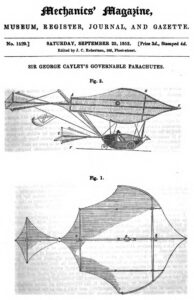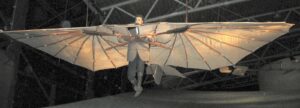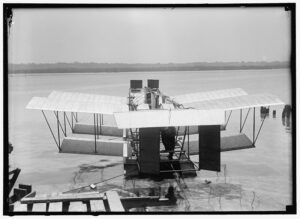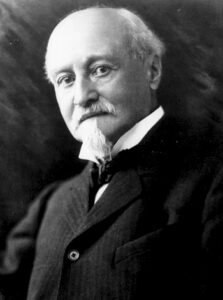August 19 has been celebrated as National Aviation Day since 1939 to honor the birth date of civil aviation pioneer Orville Wright. President Franklin Delano Roosevelt established National Aviation Day by presidential proclamation, designating the anniversary of Orville Wright’s birthday for the observance. Orville Wright was granted the honor of witnessing the moment President Roosevelt issued the proclamation before passing away in 1948. It’s an inclusive day that celebrates all things aviation, not just airplanes and pilots but also our scientists and engineers.
To celebrate this day, let’s recognize the accomplishments in advancing the first powered manned flight.
Early Designs and Attempts
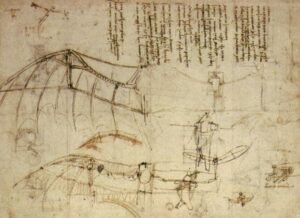 1480s: Leonardo da Vinci – The Ornithopter
1480s: Leonardo da Vinci – The Ornithopter
In the 1480s, Leonardo da Vinci made thorough studies of flight by initially studying birds. He eventually drafted a book, Codex on the Flight of Birds, which was the first document to describe dynamic soaring. Collectively, da Vinci made over 100 drawings illustrating his theories on flight.
One such design was the Ornithopter flying machine, an illustration showing a human-powered flying device. The modern-day helicopter is based on this concept.
George Cayley, an English engineer, was determined to discover a way humans could fly. His designs involved gliders controlled by movements of the human body. For over 50 years, Cayley made improvements to the gliders by experimenting with wing shapes, strengthening the glider through a biplane design, and developing a tail for improved stability. He also recognized the need for a power supply for long sustained flights.
Cayley concluded in his three-part treatise On Aerial Navigation that the best way for a man to fly is in a fixed-wing aircraft with a power system for propulsion and a tail for improved control.
1891: Otto Lilienthal
German engineer Otto Lilienthal was the first person to design a glider that could fly a person and was able to fly long distances. Based on his studies of the flight of birds, he wrote a book on aerodynamics that was published in 1889 entitled Birdflight As the Basis of Aviation, which was used by the Wright brothers as the basis for their designs.
Sadly, after more than 2,500 experimental flights, Lilienthal was killed after a sudden gust of wind caused him to lose control, sending him crashing into the ground.
Samuel Langley, an astronomer, built a model of a plane, which he called an aerodrome, that included a steam-powered engine. In 1891, his model flew for 3/4 of a mile before running out of fuel.
Due to his success, Langley received a $50,000 grant to build a full-sized aerodrome. Although it was too heavy to fly and subsequently crashed, Langley was recognized as a major contributor to the research and development of powered flight.
Octave Chanute was a French-American civil engineer who published Progress in Flying Machines in 1894. His research contained all of the technical knowledge that he could find regarding prior aviation accomplishments. The Wright brothers used Chanute’s book as a basis for much of their experiments while also seeking advice from Chanute on their technical progress.
The First Powered Flight
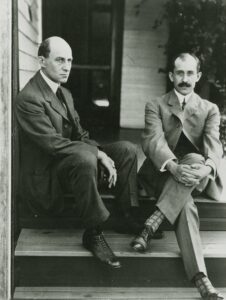 The Wright brothers were methodical in their quest to achieve the first controlled, powered, and sustained heavier-than-air human flight. Through their research, they decided to control the aircraft by having the wings twist in flight, much like having ailerons. The brothers spent three years testing and learning how gliders could be controlled at Kitty Hawk, North Carolina.
The Wright brothers were methodical in their quest to achieve the first controlled, powered, and sustained heavier-than-air human flight. Through their research, they decided to control the aircraft by having the wings twist in flight, much like having ailerons. The brothers spent three years testing and learning how gliders could be controlled at Kitty Hawk, North Carolina.
After designing a wind tunnel to test the shapes of the wings and the tails of the gliders, the brothers focused their attention on developing a propulsion system that would create sufficient thrust. For this they recruited the help of Charles Edward Taylor, a machinist, to build an engine light and powerful enough. Taylor took six weeks to build the 12-horsepower engine using a cast aluminum crankcase–a first for its time.
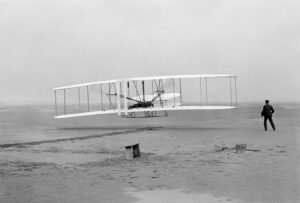 The “Flyer” took flight to the north of Big Kill Devil Hill in Kitty Hawk, North Carolina at 10:35 a.m. on December 17, 1903. Orville Wright piloted the 600-pound plane for a distance of 120 feet in 12 seconds. The brothers took turns flying the plane, with the fourth and last flight covering 852 feet in 59 seconds.
The “Flyer” took flight to the north of Big Kill Devil Hill in Kitty Hawk, North Carolina at 10:35 a.m. on December 17, 1903. Orville Wright piloted the 600-pound plane for a distance of 120 feet in 12 seconds. The brothers took turns flying the plane, with the fourth and last flight covering 852 feet in 59 seconds.
Even after an incredibly successful day, the Wright brothers continued to refine the “Flyer” for improved performance. On October 5, 1905, the brothers returned to Big Kill Devil Hill, where Wilbur Wright piloted the “Flyer III” for 39 minutes around Huffman Prairie until it ran out of gas.
Observing National Aviation Day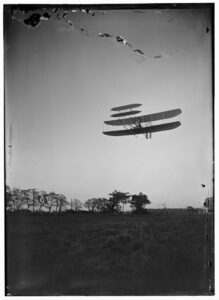
Many museums honor National Aviation Day with special exhibits and activities. In addition to airplane displays and fun exhibits that highlight the important milestones in aviation history, museums will often host events for children of all ages. A popular activity among the younger kids is designing and coloring their own paper airplanes for a distance-flight competition with their friends. Flying and assembling foam gliders or small plastic models are also fun, hands-on projects.
For middle or high school students, aviation is a great way to introduce them to STEM (science, technology, engineering, and math) concepts that are driving modern industry forward. Gleim works with a number of schools by offering STEM resources to help educators teach aviation programs. Aviation programs are an exciting way to encourage students to do well in class while also setting them on a pathway to a successful career in high demand. Download our Learn to Fly ebook to get a plain-English explanation of what it takes to become a pilot and discover other aviation career opportunities. If you already have an audience, contact us to request physical copies of the Learn to Fly booklet to share with interested students.
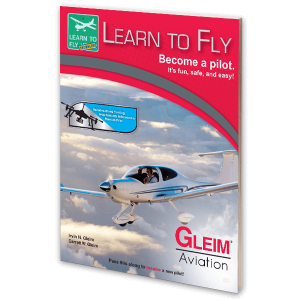 Of course, everyone’s favorite way to celebrate National Aviation Day is by taking flight, and you don’t have to go on an expensive vacation just to ride in an airplane. While Aviation Day events might look different this year due to COVID-19, we recommend searching online for virtual aviation gatherings and expos. If you’re interested in flying for a career or as a hobby, check in with local chapters of aviation organizations such as the Aircraft Owners and Pilots Association, Experimental Aircraft Association, Women in Aviation, and Civil Air Patrol to see if they’re hosting any events. You can also contact the flight school(s) in your area to see if they’re offering deals on discovery flights. If you’re already a pilot, offer a ride to your close friends and family, especially those who have never flown before.
Of course, everyone’s favorite way to celebrate National Aviation Day is by taking flight, and you don’t have to go on an expensive vacation just to ride in an airplane. While Aviation Day events might look different this year due to COVID-19, we recommend searching online for virtual aviation gatherings and expos. If you’re interested in flying for a career or as a hobby, check in with local chapters of aviation organizations such as the Aircraft Owners and Pilots Association, Experimental Aircraft Association, Women in Aviation, and Civil Air Patrol to see if they’re hosting any events. You can also contact the flight school(s) in your area to see if they’re offering deals on discovery flights. If you’re already a pilot, offer a ride to your close friends and family, especially those who have never flown before.
Consider where we would be if it weren’t for the advancements in technology that came along with the pursuit of flight. Are you able to give up your coveted two-day shipping? Do you have the time to take a boat to your next overseas vacation or meeting? Would you be willing to navigate by the constellations instead of using a GPS?
Ultimately, National Aviation Day is about sharing the joy and wonder of aviation with our friends and family. Tell someone about the holiday and reflect with them on the ways aviation has affected your lives. Our fascination with flight has given us many great successes and has changed the way society functions for the better. As the saying goes, “Aviation shrunk the world.” We hope that you find fun ways to celebrate how aviation has brought us all closer together.
Written by: Ryan Jeff, Aviation Research Assistant



